Ein Doppelpack, der WiP zu beiden ARII 1:100 VF-1en und ein paar Hintergründe zu den kleinen Grünlingen findet sich hier:
http://www.phoxim.de/forum/index.php?topic=32443.0
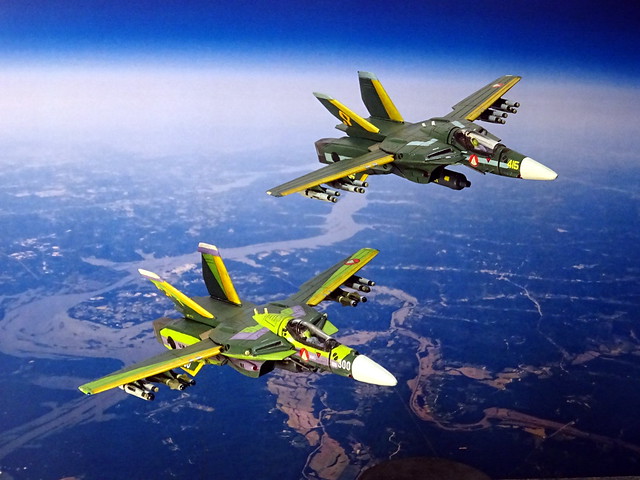
1:100 Stonewell/Bellcom VF-1J Plus Valkyrie; aircraft "300", mount of 3rd Flight Leader Taqisha T’saqeel, and VF-1A "415" of SVF-789 ‘Dar es Carrack’ of the U.N. Spacy Zentraedi Fleet; Tefé Amazonia Base, Brazil; early 2013 (modified ARII kit) by
dizzyfugu, on Flickr
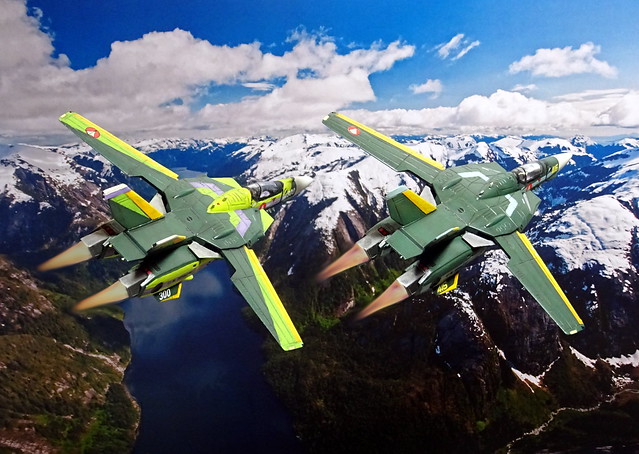
1:100 Stonewell/Bellcom VF-1J Plus Valkyrie; aircraft "300", mount of 3rd Flight Leader Taqisha T’saqeel, and VF-1A "415" of SVF-789 ‘Dar es Carrack’ of the U.N. Spacy Zentraedi Fleet; Tefé Amazonia Base, Brazil; early 2013 (modified ARII kit) by
dizzyfugu, on Flickr
Some background:The VF-1 was developed by Stonewell/Bellcom/Shinnakasu for the U.N. Spacy by using alien Overtechnology obtained from the SDF-1 Macross alien spaceship. It was preceded into production by an aerodynamic proving version of its airframe, the VF-X. Unlike all later VF vehicles, the VF-X was strictly a jet aircraft, built to demonstrate that a jet fighter with the features necessary to convert to Battroid mode was aerodynamically feasible.
After the VF-X's testing was finished, an advanced concept atmospheric-only prototype, the VF-0 Phoenix, was flight-tested from 2005 to 2007 and briefly served as an active-duty fighter from 2007 to the VF-1's rollout in late 2008, while the bugs were being worked out of the full-up VF-1 prototype (VF-X-1).
The space-capable VF-1's combat debut was on February 7, 2009, during the Battle of South Ataria Island - the first battle of Space War I, and was the mainstay fighter of the U.N. Spacy for the entire conflict. Introduced in 2008, the VF-1 would be out of frontline service just five years later.
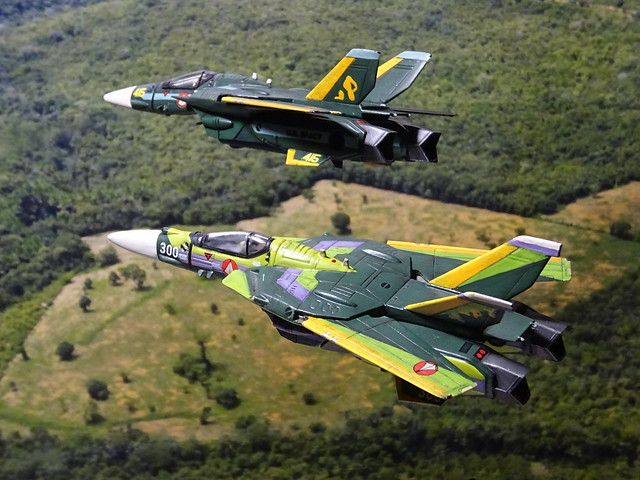
1:100 Stonewell/Bellcom VF-1J Plus Valkyrie; aircraft "300", mount of 3rd Flight Leader Taqisha T’saqeel, and VF-1A "415" of SVF-789 ‘Dar es Carrack’ of the U.N. Spacy Zentraedi Fleet; Tefé Amazonia Base, Brazil; early 2013 (modified ARII kit) by dizzyfugu, on Flickr
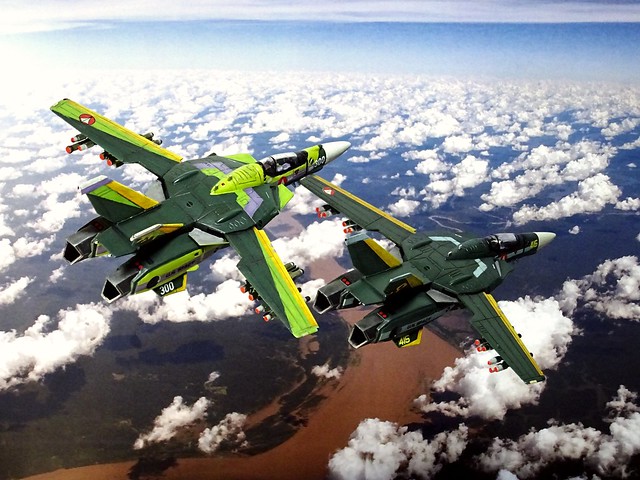
1:100 Stonewell/Bellcom VF-1J Plus Valkyrie; aircraft "300", mount of 3rd Flight Leader Taqisha T’saqeel, and VF-1A "415" of SVF-789 ‘Dar es Carrack’ of the U.N. Spacy Zentraedi Fleet; Tefé Amazonia Base, Brazil; early 2013 (modified ARII kit) by dizzyfugu, on Flickr
The VF-1 proved to be an extremely capable craft, successfully combating a variety of Zentraedi mecha even in most sorties, which saw UN Spacy forces significantly outnumbered. The versatility of the Valkyrie design enabled the variable fighter to act as both large-scale infantry and as air/space superiority fighter. The signature skills of U.N. Spacy ace pilot Maximilian Jenius exemplified the effectiveness of the variable systems as he near-constantly transformed the Valkyrie in battle to seize advantages of each mode as combat conditions changed from moment to moment.
The basic VF-1 was deployed in four minor variants (designated A, D, J, and S) with constant updates and several sub-variants during its long and successful career. Its success was increased by the GBP-1S "Armored" Valkyrie and FAST Pack "Super" Valkyrie weapon systems, the latter enabling the fighter to operate in space.
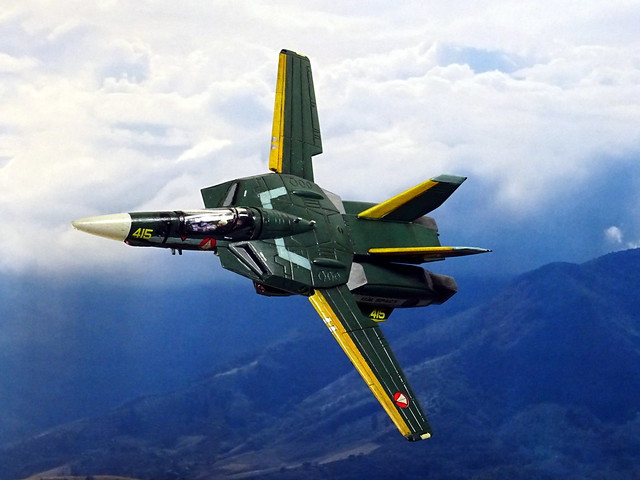
1:100 Stonewell/Bellcom VF-1A Valkyrie; "415" of SVF-789 ‘Dar es Carrack’, U.N. Spacy Zentraedi Fleet; Tefé Amazonia Base, Brazil; early 2013 (ARII kit) by dizzyfugu, on Flickr
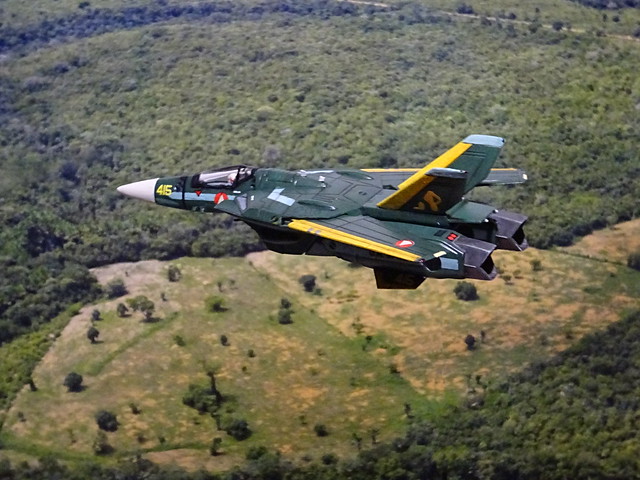
1:100 Stonewell/Bellcom VF-1A Valkyrie; "415" of SVF-789 ‘Dar es Carrack’, U.N. Spacy Zentraedi Fleet; Tefé Amazonia Base, Brazil; early 2013 (ARII kit) by dizzyfugu, on Flickr
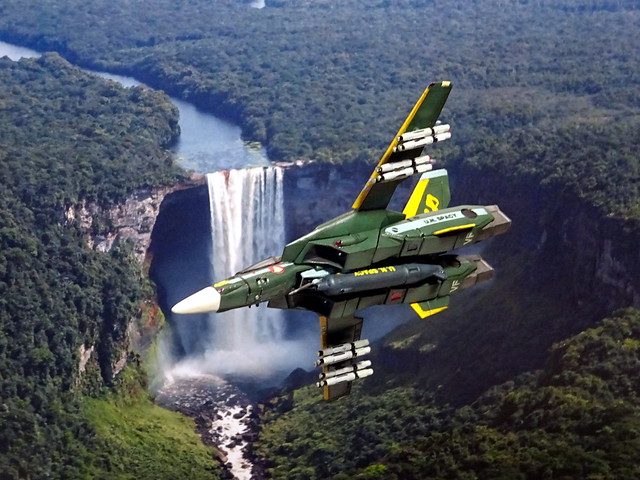
1:100 Stonewell/Bellcom VF-1A Valkyrie; "415" of SVF-789 ‘Dar es Carrack’, U.N. Spacy Zentraedi Fleet; Tefé Amazonia Base, Brazil; early 2013 (ARII kit) by dizzyfugu, on Flickr
After the end of Space War I, the VF-1A continued to be manufactured both in the Sol system (notably on the Lunar facility Apollo Base) and throughout the UNG space colonies. Although the VF-1 would eventually be replaced as the primary VF of the UN Spacy by the more capable, but also much bigger, VF-4 Lightning III in 2020, a long service record and continued production after the war proved the lasting worth of the design.
One notable operator of the VF-1 was the U.N. Spacy's Zentraedi Fleet, namely SVF-789, which was founded in 2012 as a cultural integration and training squadron with two flights of VF-1 at Tefé in Brazil. This mixed all-Zentraedi/Meltraedi unit was the first in the UN Spacy’s Zentraedi Fleet to be completely equipped with the 1st generation Valkyrie (other units, like SVF-122, which was made up exclusively from Zentraedi loyalists, kept a mixed lot of vehicles).
SVF-789’s flight leaders and some of its instructors were all former Quadrono Battalion aces (under the command of the famous Milia Fallyna, later married with aforementioned Maximilian Jenius), e. g. the Meltraedi pilot Taqisha T’saqeel who commanded SVF-789’s 3rd Flight.
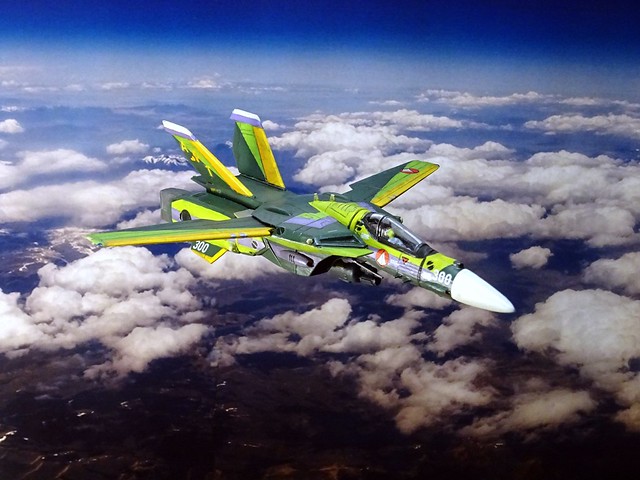
1:100 Stonewell/Bellcom VF-1J Plus Valkyrie; aircraft "300", mount of 3rd Flight Leader Taqisha T’saqeel, SVF-789 ‘Dar es Carrack’ of the U.N. Spacy Zentraedi Fleet; Tefé Amazonia Base, Brazil; early 2013 (modified ARII kit) by dizzyfugu, on Flickr
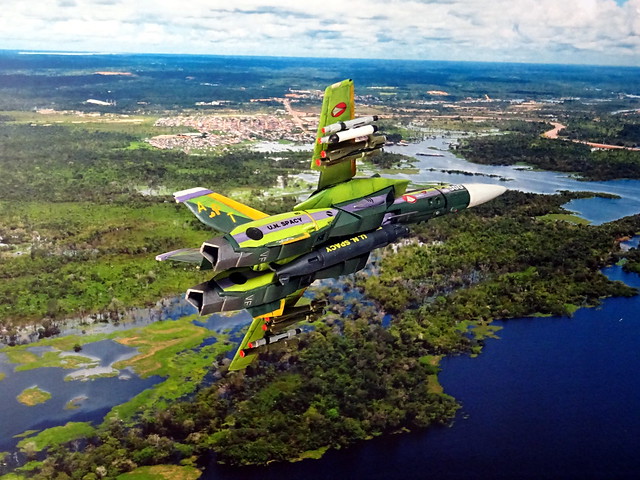
1:100 Stonewell/Bellcom VF-1J Plus Valkyrie; aircraft "300", mount of 3rd Flight Leader Taqisha T’saqeel, SVF-789 ‘Dar es Carrack’ of the U.N. Spacy Zentraedi Fleet; Tefé Amazonia Base, Brazil; early 2013 (modified ARII kit) by dizzyfugu, on Flickr
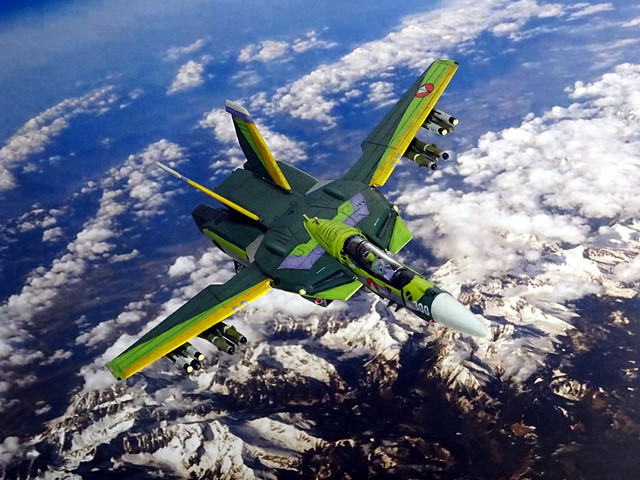
1:100 Stonewell/Bellcom VF-1J Plus Valkyrie; aircraft "300", mount of 3rd Flight Leader Taqisha T’saqeel, SVF-789 ‘Dar es Carrack’ of the U.N. Spacy Zentraedi Fleet; Tefé Amazonia Base, Brazil; early 2013 (modified ARII kit) by dizzyfugu, on Flickr
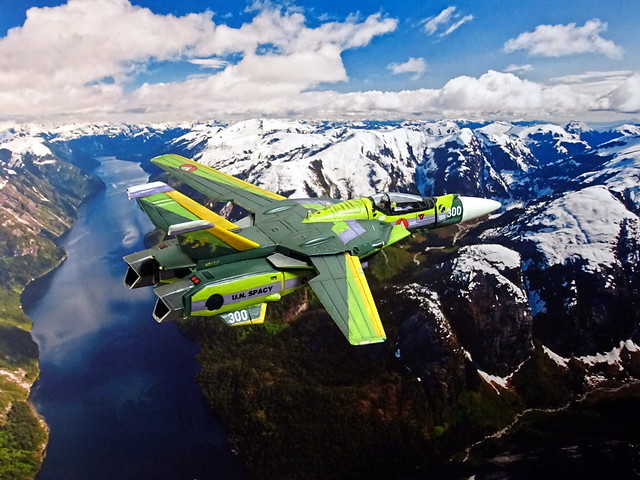
1:100 Stonewell/Bellcom VF-1J Plus Valkyrie; aircraft "300", mount of 3rd Flight Leader Taqisha T’saqeel, SVF-789 ‘Dar es Carrack’ of the U.N. Spacy Zentraedi Fleet; Tefé Amazonia Base, Brazil; early 2013 (modified ARII kit) by dizzyfugu, on Flickr
Almost all future Zentraedi and Meltradi pilots for the U.N. Spacy received their training at Tefé, and the squadron was soon expanded to a total of five flights. During this early phase of the squadron's long career the VF-1s carried a characteristic dark-green wrap-around scheme, frequently decorated with colorful trim, reflecting the unit’s Zentraedi/Meltraedi heritage (the squadron’s motto and title “Dar es Carrack” meant “Victory is everywhere”) and boldly representing the individual flights.
In late 2013 the unit embarked upon Breetai Kridanik’s Nupetiet-Vergnitzs-Class Fleet Command Battleship, and the machines received a standard all-grey livery, even though some typical decoration (e. g. the squadron code in Zentraedi symbols) remained.
When the UN Spacy eventually mothballed the majority of its legacy Zentraedi ships, the unit was re-assigned to the Tokugawa-class Super Dimensional Carrier UES Xerxes. In 2022, SVF-789 left the Sol System as part of the Pioneer Mission. By this time it had been made part of the Expeditionary Marine Corps and re-equipped with VAF-6 Alphas.
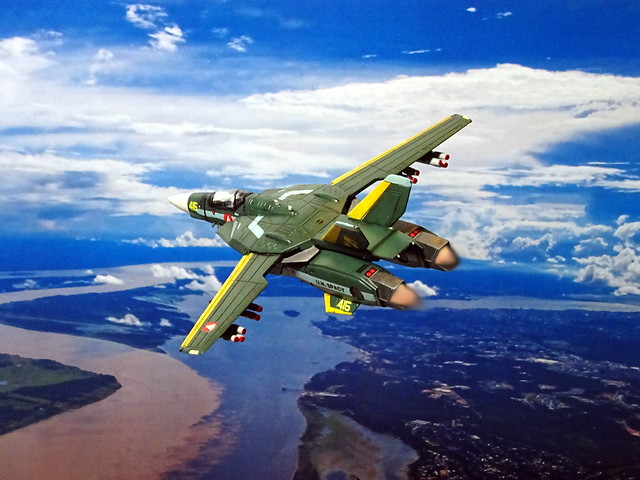
1:100 Stonewell/Bellcom VF-1A Valkyrie; "415" of SVF-789 ‘Dar es Carrack’, U.N. Spacy Zentraedi Fleet; Tefé Amazonia Base, Brazil; early 2013 (ARII kit) by dizzyfugu, on Flickr
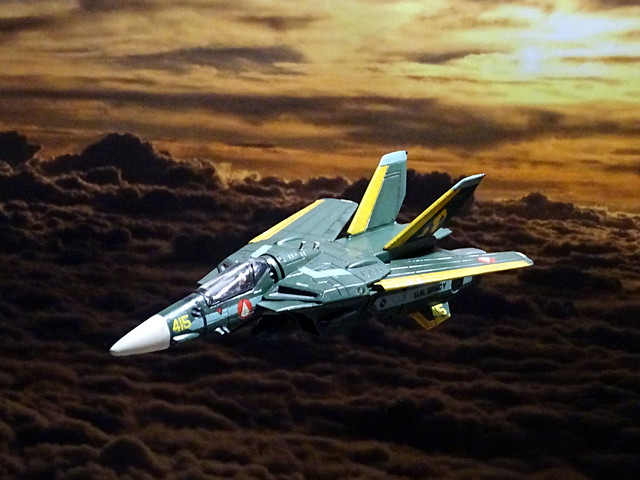
1:100 Stonewell/Bellcom VF-1A Valkyrie; "415" of SVF-789 ‘Dar es Carrack’, U.N. Spacy Zentraedi Fleet; Tefé Amazonia Base, Brazil; early 2013 (ARII kit) by dizzyfugu, on Flickr
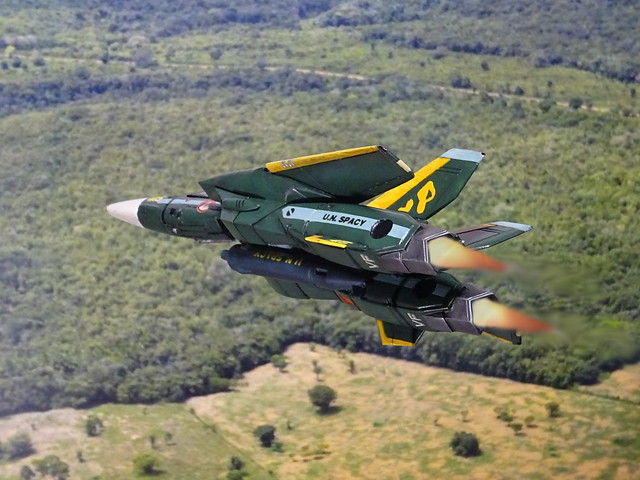
1:100 Stonewell/Bellcom VF-1A Valkyrie; "415" of SVF-789 ‘Dar es Carrack’, U.N. Spacy Zentraedi Fleet; Tefé Amazonia Base, Brazil; early 2013 (ARII kit) by dizzyfugu, on Flickr
The VF-1 was without doubt the most recognizable variable fighter of Space War I and was seen as a vibrant symbol of the U.N. Spacy even into the first year of the New Era 0001 in 2013. At the end of 2015 the final rollout of the VF-1 was celebrated at a special ceremony, commemorating this most famous of variable fighters.
The VF-1 Valkryie was built from 2006 to 2013 with a total production of 5,459 VF-1 variable fighters with several variants (VF-1A = 5,093, VF-1D = 85, VF-1J = 49, VF-1S = 30, VF-1G = 12, VE-1 = 122, VT-1 = 68) and ongoing modernization programs like the “Plus” MLU update that incorporated stronger engines and avionics from the VF-1’s successor, the VF-4 (including the more powerful radar, IRST sensor and a laser designator/range finder). These updates later led to the VF-1N, P an X variants. However, the fighter remained active in many second line units and continued to show its worthiness years later, e. g. through Milia Jenius who would use her old VF-1 fighter in defense of the colonization fleet - 35 years after the type's service introduction!
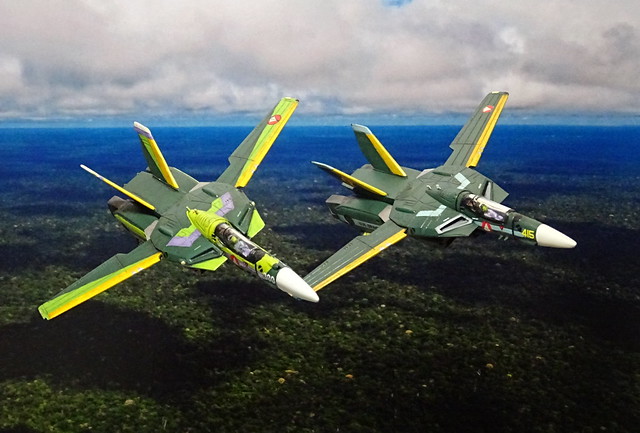
1:100 Stonewell/Bellcom VF-1J Plus Valkyrie; aircraft "300", mount of 3rd Flight Leader Taqisha T’saqeel, and VF-1A "415" of SVF-789 ‘Dar es Carrack’ of the U.N. Spacy Zentraedi Fleet; Tefé Amazonia Base, Brazil; early 2013 (modified ARII kit) by dizzyfugu, on Flickr
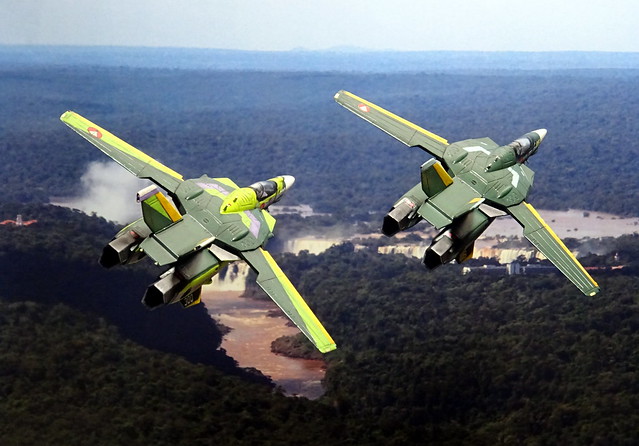
1:100 Stonewell/Bellcom VF-1J Plus Valkyrie; aircraft "300", mount of 3rd Flight Leader Taqisha T’saqeel, and VF-1A "415" of SVF-789 ‘Dar es Carrack’ of the U.N. Spacy Zentraedi Fleet; Tefé Amazonia Base, Brazil; early 2013 (modified ARII kit) by dizzyfugu, on Flickr
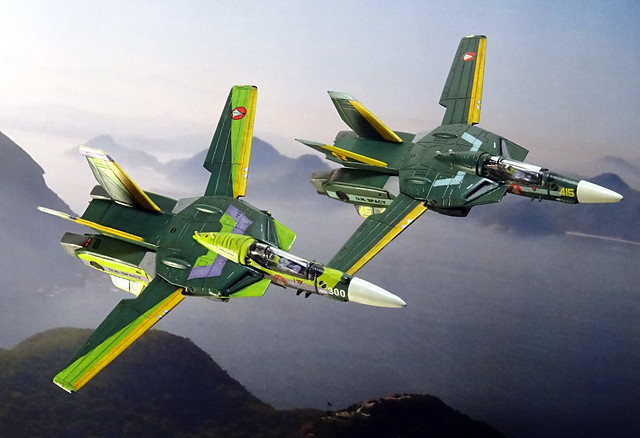
1:100 Stonewell/Bellcom VF-1J Plus Valkyrie; aircraft "300", mount of 3rd Flight Leader Taqisha T’saqeel, and VF-1A "415" of SVF-789 ‘Dar es Carrack’ of the U.N. Spacy Zentraedi Fleet; Tefé Amazonia Base, Brazil; early 2013 (modified ARII kit) by dizzyfugu, on Flickr
General characteristics:Equipment Type: all-environment variable fighter and tactical combat battroid
Government: U.N. Spacy, U.N. Navy, U.N. Space Air Force
Accommodation: pilot only in Marty & Beck Mk-7 zero/zero ejection seat
Dimensions:
Fighter Mode:
Length 14.23 meters
Wingspan 14.78 meters (fully extended)
Height 3.84 meters
Battroid Mode:
Height 12.68 meters
Width 7.3 meters
Length 4.0 meters
Empty weight: 13.25 metric tons;
Standard T-O mass: 18.5 metric tons;
MTOW: 37.0 metric tons
Powerplant:2x Shinnakasu Heavy Industry/P&W/Roice FF-2008 thermonuclear reaction turbine engines, output 650 MW each, rated at 11,500 kg in standard or in overboost (225.63 kN x 2)
4 x Shinnakasu Heavy Industry NBS-1 high-thrust vernier thrusters (1 x counter reverse vernier thruster nozzle mounted on the side of each leg nacelle/air intake, 1 x wing thruster roll control system on each wingtip);
18 x P&W LHP04 low-thrust vernier thrusters beneath multipurpose hook/handles
Performance:Battroid Mode: maximum walking speed 160 km/h
Fighter Mode: at 10,000 m Mach 2.71; at 30,000+ m Mach 3.87
g limit: in space +7
Thrust-to-weight ratio: empty 3.47; standard T-O 2.49; maximum T-O 1.24
Design features:3-mode variable transformation; variable geometry wing; vertical take-off and landing; control-configurable vehicle; single-axis thrust vectoring; three "magic hand" manipulators for maintenance use; retractable canopy shield for Battroid mode and atmospheric reentry; option of GBP-1S system, atmospheric-escape booster, or FAST Pack system
Transformation:Standard time from Fighter to Battroid (automated): under 5 sec.
Minimum time from Fighter to Battroid (manual): 0.9 sec.
Armament:2x internal Mauler RÖV-20 anti-aircraft laser cannon, firing 6,000 pulses per minute
1x Howard GU-11 55 mm three-barrel Gatling gun pod with 200 rds fired at 1,200 rds/min
4 x underwing hard points for a wide variety of ordnance, including
- 12x AMM-1 hybrid guided multipurpose missiles (3/point), or
- 12x MK-82 LDGB conventional bombs (3/point), or
- 6x RMS-1 large anti-ship reaction missiles (2/outboard point, 1/inboard point), or
- 4x UUM-7 micro-missile pods (1/point), each carrying 15x Bifors HMM-01 micro-missiles,
or a combination of above load-outs
Optional Armament:Shinnakasu Heavy Industry GBP-1S ground-combat protector weapon system, or
Shinnakasu Heavy Industry FAST Pack augmentative space weapon system
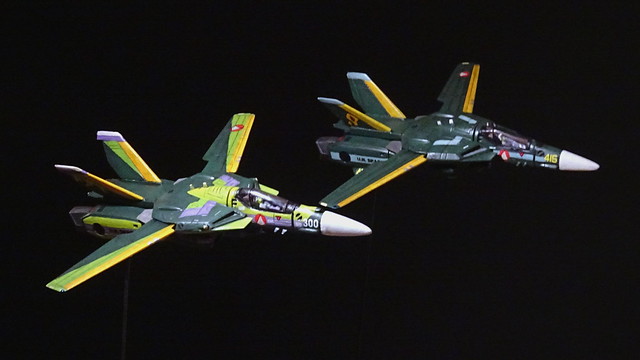
1:100 Stonewell/Bellcom VF-1J Plus Valkyrie; aircraft "300", mount of 3rd Flight Leader Taqisha T’saqeel, and VF-1A "415" of SVF-789 ‘Dar es Carrack’ of the U.N. Spacy Zentraedi Fleet; Tefé Amazonia Base, Brazil; early 2013 (modified ARII kit) by
dizzyfugu, on Flickr
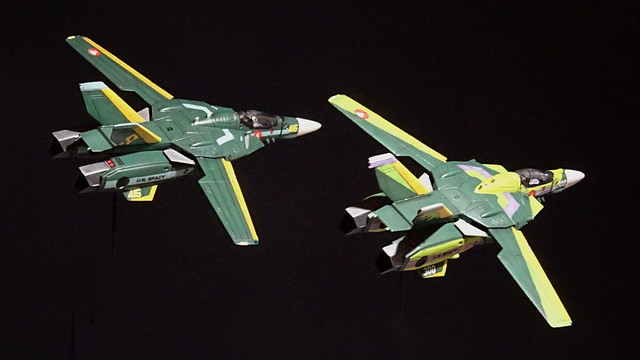
1:100 Stonewell/Bellcom VF-1J Plus Valkyrie; aircraft "300", mount of 3rd Flight Leader Taqisha T’saqeel, and VF-1A "415" of SVF-789 ‘Dar es Carrack’ of the U.N. Spacy Zentraedi Fleet; Tefé Amazonia Base, Brazil; early 2013 (modified ARII kit) by
dizzyfugu, on Flickr
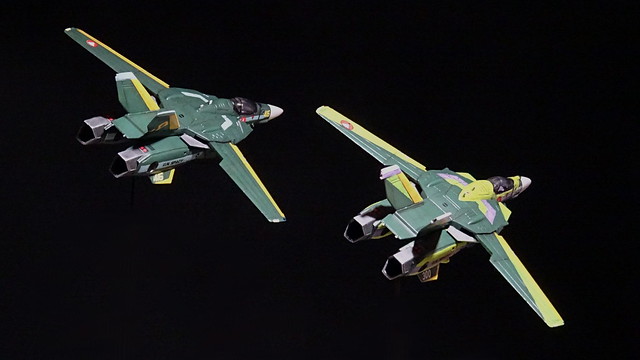
1:100 Stonewell/Bellcom VF-1J Plus Valkyrie; aircraft "300", mount of 3rd Flight Leader Taqisha T’saqeel, and VF-1A "415" of SVF-789 ‘Dar es Carrack’ of the U.N. Spacy Zentraedi Fleet; Tefé Amazonia Base, Brazil; early 2013 (modified ARII kit) by
dizzyfugu, on Flickr
Ein exotisches Thema, basierend auf ein paar vagen, kanonischen Informationen. Der Bau war eigentlich recht simpel, nur die neue Radarnase der VF-1J war etwas knifflig - ein subtiler Eingriff, den man wirklich nur im direkten Vergleich erkennt. Die simple VF-1A war auch noch rel. einfach anzumalen, bei der bunteren "J" hat es denn doch ein paar Tage gekostet, das Schema auszuklüngeln und irgendwie auf das kleine und verwinkelte Modell zu bringen. Dafür sieht das Paar wirklich "anders" aus - und es ist noch mehr von SVF-789 in der Pipeline, denn es soll auch noch eine 1:8-Figur, die Pilotin von "300", folgen.
